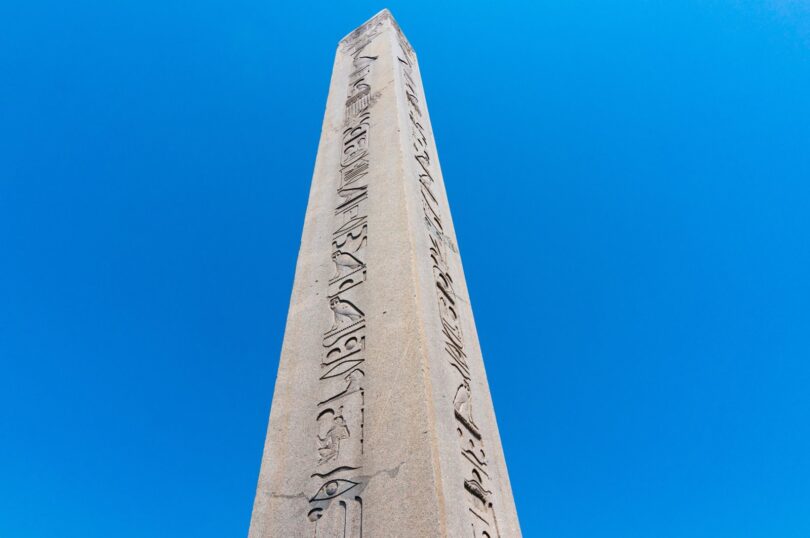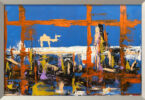Betül Tilmaç
ISTANBUL : The majesty and mystique of Istanbul’s rich culture are illuminated by legend-filled talismanic columns. With their discovery in ancient Egypt and their use in Byzantine culture, talismanic pillars have piqued people’s curiosity for centuries
Talismanic columns, often referred to as wish columns or prayer columns, are architectural features that may be found in many Muslim-majority towns, including Istanbul. The inscriptions and embellishments on these columns, which are often built of stone or marble, are intended to ward off danger and provide good fortune to anybody who touches them or makes a wish upon them.
People believed that through these pillars they would discover prosperity, abundance and a solution to their problems as well as gain protection from diseases, catastrophes, earthquakes and reptiles. Also, several dynasty members are believed to have discovered the remedy they were looking for from these stones, according to stories.
Selçuk Eracun, a researcher, writer and professional history guide who has spent a lot of time at cultural landmarks like Hagia Sophia, spoke to Daily Sabah about Istanbul’s talismanic columns.
Obelisk of Theodosius
Late in the A.D. fourth century, Roman Emperor Theodosius I transported the obelisk to Constantinople. One of the tallest obelisks in the world, the Obelisk of Theodosius, known as “Dikilitaş” in Turkish, is composed of pink granite and is 20.48 meters (67 feet) tall. On the base of the obelisk, in addition to the hieroglyphics, there are reliefs that show scenes from Theodosius I’s rule. The monument is a well-liked tourist destination that draws people from all over the world. It is also a significant historical and cultural marker of Istanbul’s varied and rich past.
“Some people think that the obelisk is located on the ley line. It’s thought that the obelisk is on a power line and acts as an antenna. At its base, the obelisk is supported by four bronze metal columns. As copper, granite and water are often conductive materials, some experts believe that this was done on purpose and that the location of the construction was not an accident. After a 60-year voyage from Egypt to Istanbul, it was brought here upon Theodosius’ request. It took a month only to get the obelisk to Sultanahmet Square. Only a third of the column is visible today since the obelisk was fractured in certain places while being transported to Istanbul,” Eracun said.
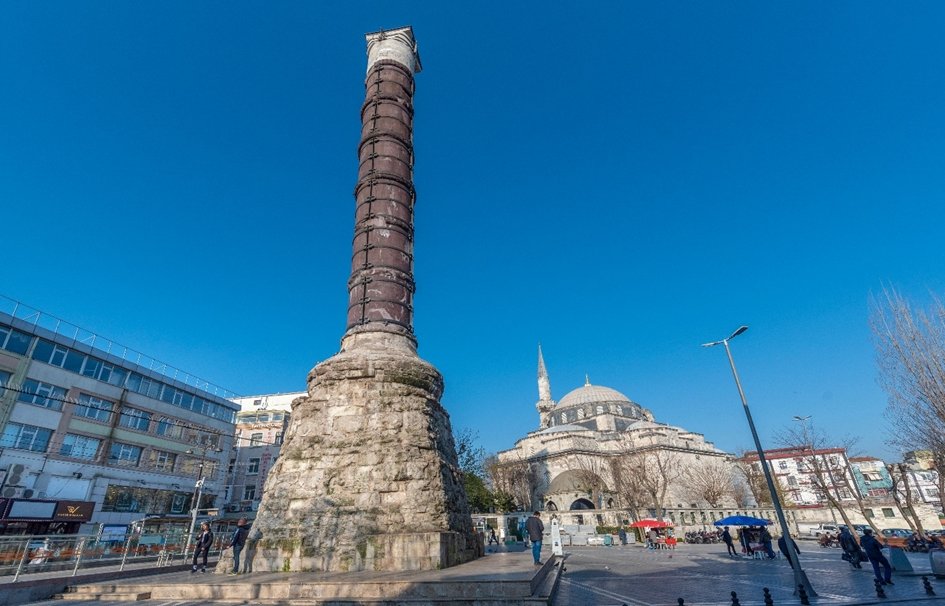
Masonry Obelisk
The Masonry Obelisk, known as “Örme Dikilitaş,” was erected in the Hippodrome of Constantinople in the A.D. fourth century during the reign of the Roman Emperor Theodosius I. The obelisk was set on a base built of masonry blocks when it was carried to Constantinople. It is regarded as a representation of tenacity and strength in Turkish culture.
According to Evliya Çelebi, it was supposed that the summit of the column in Sultanahmet Square, which was constructed by fusing 300,000 stones, had a massive magnet that served as a shield against earthquakes.
In his writings, Evliya Çelebi said: “A talismanic iron shaft built by a skilled architect was topped with a magnet the size of a bath dome and had stones poured into its four corners. The iron shaft is pulled by this magnet. Thanks to this tower, which was encircled by colored stones, the city was shielded from earthquakes.”
A myth claims that the stones on each of these engraved plates, were transported from different regions of the country and that the names of the Roman troops and officers who worked during the process were inscribed on the stones.
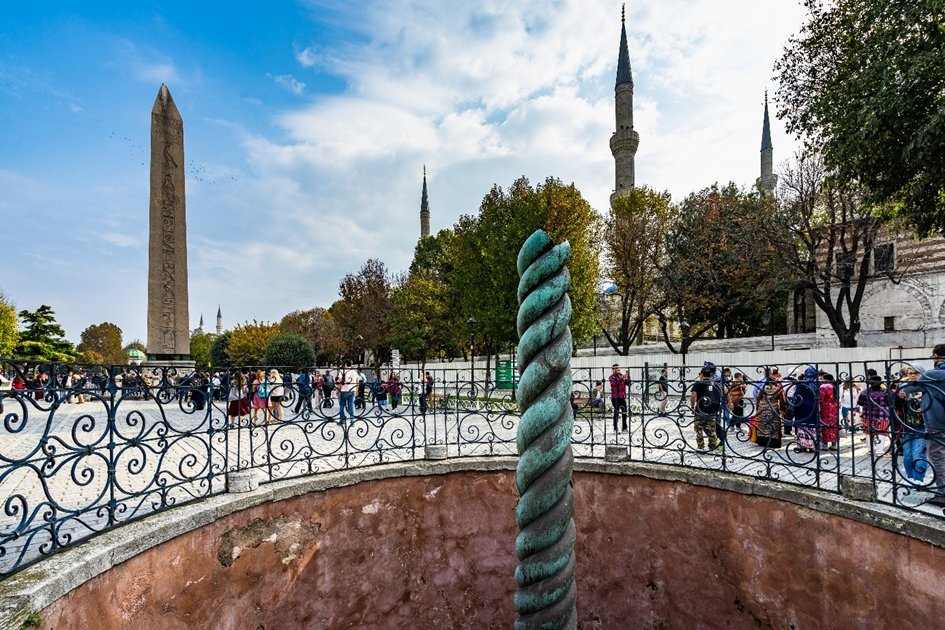
Column of Constantine
The Column of Constantine, also known as the Burnt Column or the “Çemberlitaş Obelisk,” is a historical landmark located in the heart of Istanbul. The column, which was built in the A.D. fourth century to mark Constantine’s victory over his opponent Maxentius, is a notable representation of Istanbul’s extensive historical and cultural heritage.
The Column of Constantine is regarded as having talismanic qualities in addition to its historical and cultural value. It was thought that this column shielded the nation from evil, illnesses and hatred. Many residents and visitors think that making a wish or touching the column will bring luck and riches. It’s a pillar where you frequently see people taking pictures and making wishes, both tourists and locals.
“Constantine is thought to have converted to Christianity in his final moments. Allegedly, Jesus buried the holy treasures, including his clothing, under the Column of Constantine. A statue of Constantine once stood atop the column, signifying that he was a deity; but, during the Christian era, it was removed and replaced with a bronze cross. Of course, the cross was removed from the column after a while. Then a fire breaks out, and after the fire, rings have been placed around it to prevent it from collapsing.” Eracun elaborated.
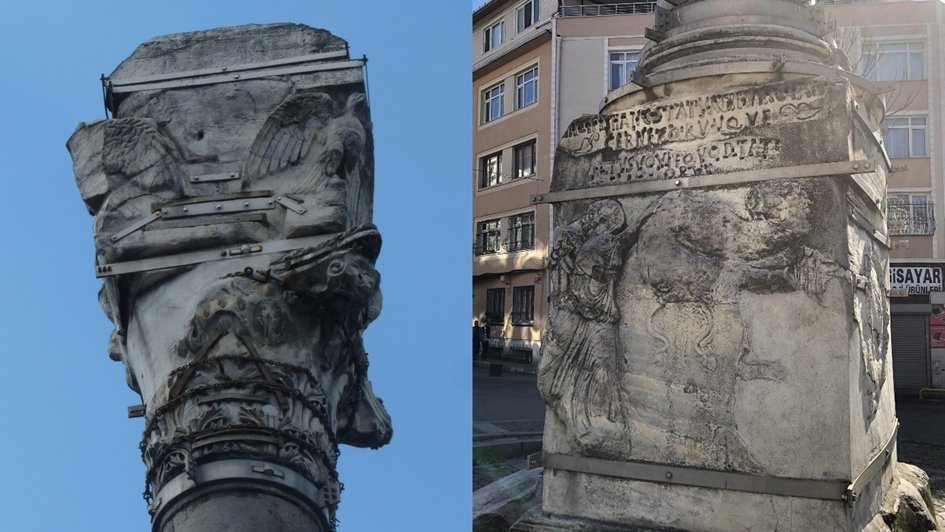
Column of Marcian
The tall, cylindrical Column of Marcian, or “Kıztaşı” (“Girl’s Stone”), was built in the A.D. fifth century to honor the Persian victory over the Byzantine Emperor Marcian. Many people believed that the one who touches the column and makes a wish thinks their wishes come true thanks to its talismanic characteristics. The emperor’s daughter was also said to be protected by this talismanic column from ants, centipedes and snakes.
The Column of Marcian, which is made out of a column standing on a big plinth, is situated in Istanbul’s Fatih district. The marble column is roughly 12 meters high. Many urban legends about Istanbul’s Marcian Column are still known. A kind of magic that provides all Istanbul’s girls’ fertility, according to a legend, was cast by a witch who built the Column of Marcian.
“It’s said that a girl wanted to travel to Istanbul with the enormous column she carried there and use it to build the Hagia Sophia. Although it was impossible for a girl to carry that stone on her back, she did it because the stone was a talisman, and she didn’t feel its weight,” Eracun said.
“The jinn on the road tricked the girl as she traveled to Istanbul. It told her: ‘You are late, Hagia Sophia is constructed, you don’t need to carry this stone, simply go back to your home,’ The girl left the stone somewhere after traveling this far because she wanted to see Hagia Sophia. When she arrived, she discovered that the construction didn’t begin. Angered by this, the girl decided to return and retrieve the stone, but it didn’t move because the talisman was broken. Under the column, there are some angel reliefs. It looks like a woman, hence it is called as ‘Kıztaşı,'” he elaborated.
Serpent Column
An intriguing historical monument that has endured the test of time for more than 2,500 years is Istanbul’s Serpent Column. The Serpent Column is an ancient Greek relic that has long been admired and is situated in the Hippodrome of Constantinople, today known as Sultanahmet Square. In 479 B.C., the Serpent Column was built in Constantinople’s Hippodrome to honor the Greeks’ victory over the Persians at the Battle of Plataea. The column was formed of three bronze serpents coiling around a central column and was initially found at the Temple of Apollo at Delphi, Greece. The column was used in religious rituals as well, and its serpents were thought to have magical powers.
This monument was said to possess mystical properties, shielding the city from insects and reptiles. The column’s serpents also have symbolic significance in both Greek and Turkish culture. The serpent was a popular figure in ancient Greek art and literature because it was thought to provide wisdom and healing. In Turkish culture, the serpent is seen as a symbol of strength and wisdom and is often used in folk tales and myths.
Courtesy: Dailysabah

